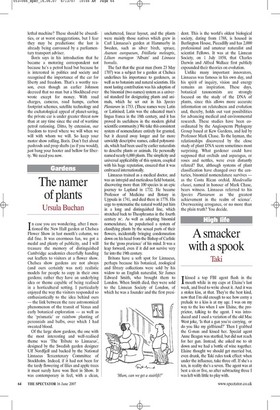The namer of plants
Ursula Buchan In case you are wondering, after I mentioned the New Hall garden at Chelsea Flower Show in last month's column, we did fine. It was enormous fun, we got a medal and plenty of publicity, and I will treasure the memory of distinguished Cambridge academics cheerfully handing out leaflets to visitors at a flower show. Chelsea show gardens are not always (and ours certainly was not) realistic models for people to copy in their own gardens; rather they have an underlying idea or theme capable of being realised in a horticultural setting. I particularly enjoyed the way the visitors responded so enthusiastically to the idea behind ours — the link between the rare astronomical phenomenon of the transit of Venus and early botanical exploration — as well as the 'prismatic' or rainbow planting of perennials and bulbs, over which I had sweated blood.
Of the large show gardens, the one with the most interesting and well-realised theme was 'The Tribute to Linnaeus', designed by the Swedish garden designer Ulf Nordfjell and backed by the National Linnaeus Tercentenary Committee of Stockholm. Indeed, if it had not been for the tardy flowering of lilies and apple trees it must surely have won Best in Show. It was contemporary in feel, with a clean, uncluttered, linear layout, and the plants were mainly those natives which grew in Carl Linnaeus's garden at Hammarby in Sweden, such as silver birch, spruce, Asantm europaeum, Fritillaria meleagris, 'ilium martagon 'Album' and Linnaea borealis.
The fact that the great man (born 23 May 1707) was a subject for a garden at Chelsea underlines his importance to gardeners, as well as to botanists and natural scientists. His most lasting contribution was his adoption of the binomial (two names) system as a universal standard for designating plants and animals, which he set out in his Species Plantantm in 1753. (These names were Latin or Latinised; Latin was the educated man's lingua franca in the 18th century, and it has proved its usefulness in the modern global scientific community.) We take this consistent system of nomenclature entirely for granted, but it cleared away longer and far more unwieldy descriptive names, called polynomials, which had been used by earlier naturalists to describe plants or animals. He personally named nearly 6,000 plants. The simplicity and universal applicability of this system, coupled with his huge reputation, ensured that it was embraced internationally.
Linnaeus trained as a medical doctor, and was an intrepid and meticulous field botanist, discovering more than 100 species in an epic journey to Lapland in 1732. He became Professor of Medicine and Botany in Uppsala in 1741, and died there in 1778. His urge to systematise the natural world put him in a long and distinguished line, which stretched back to Theophrastus in the fourth century sc. As well as adopting binomial nomenclature, he popularised a system of classifying plants by the sexual parts of their flowers, incidentally bringing condemnation down on his head from the Bishop of Carlisle for the 'gross prurience' of his mind. It was a leap forward, even if it did not survive very far into the 19th century.
Britons have a soft spot for Linnaeus, perhaps because his botanical, zoological and library collections were sold by his widow to an English naturalist, Sir James Edward Smith, who brought them to London. When Smith died, they were sold to the Linnean Society of London, of which he was a founder and the first president. This is the world's oldest biological society, dating from 1788, is housed in Burlington House, Piccadilly and has 2,000 professional and amateur naturalist and scientist Fellows. It was at the Linnean Society, on 1 July 1858, that Charles Darwin and Alfred Wallace first publicly expounded their theories on evolution.
Unlike many important innovators, Linnaeus was famous in his own day, and his spirit of inquiry, vision and energy remains an inspiration. These days, botanical taxonomists are strongly focused on the study of the DNA of plants, since this allows more accurate information on relatedness and evolution and, thereby, holds out vast possibilities for advancing medical and environmental research. These studies have been coordinated by the Angiosperm Phylogeny Group based at Kew Gardens, and led by Professor Mark Chase. To the layman, the relationships discovered by the close study of plant DNA seem sometimes most surprising. What gardener could have supposed that orchids and asparagus, or roses and nettles, were even distantly related? But, although systems of plant classification have changed over the centuries, binomial nomenclature survives — as the Costa Rican orchid, Masdevallia chasei, named in honour of Mark Chase, bears witness. Linnaeus referred to his Species Plantarum as 'the greatest achievement in the realm of science'. Overweening arrogance, or no more than the plain truth? You decide.




















































 Previous page
Previous page